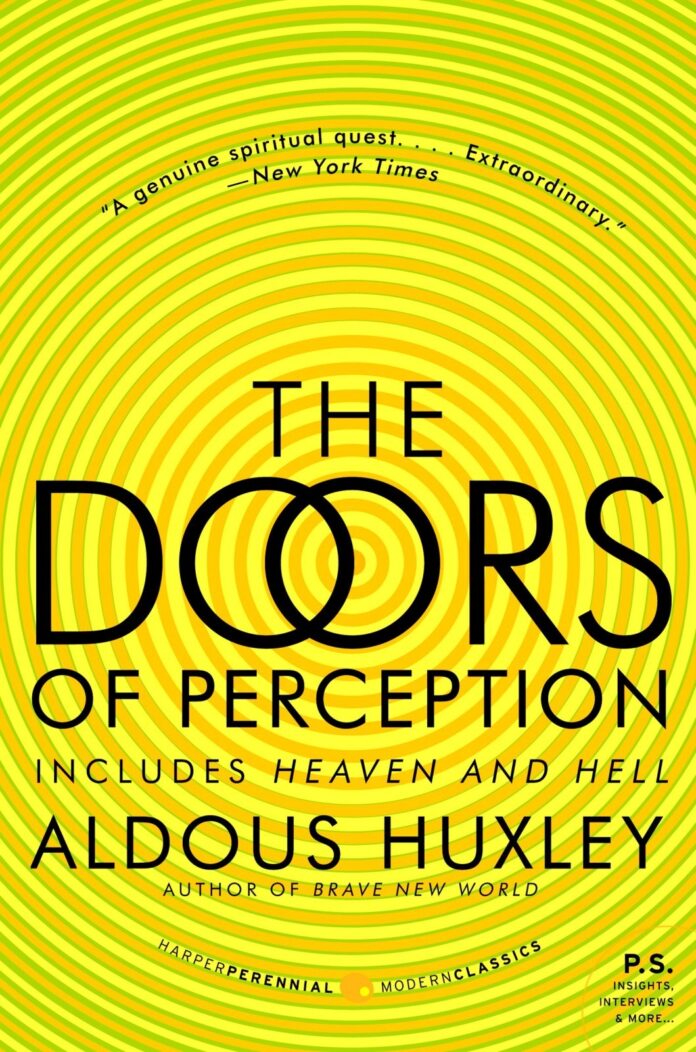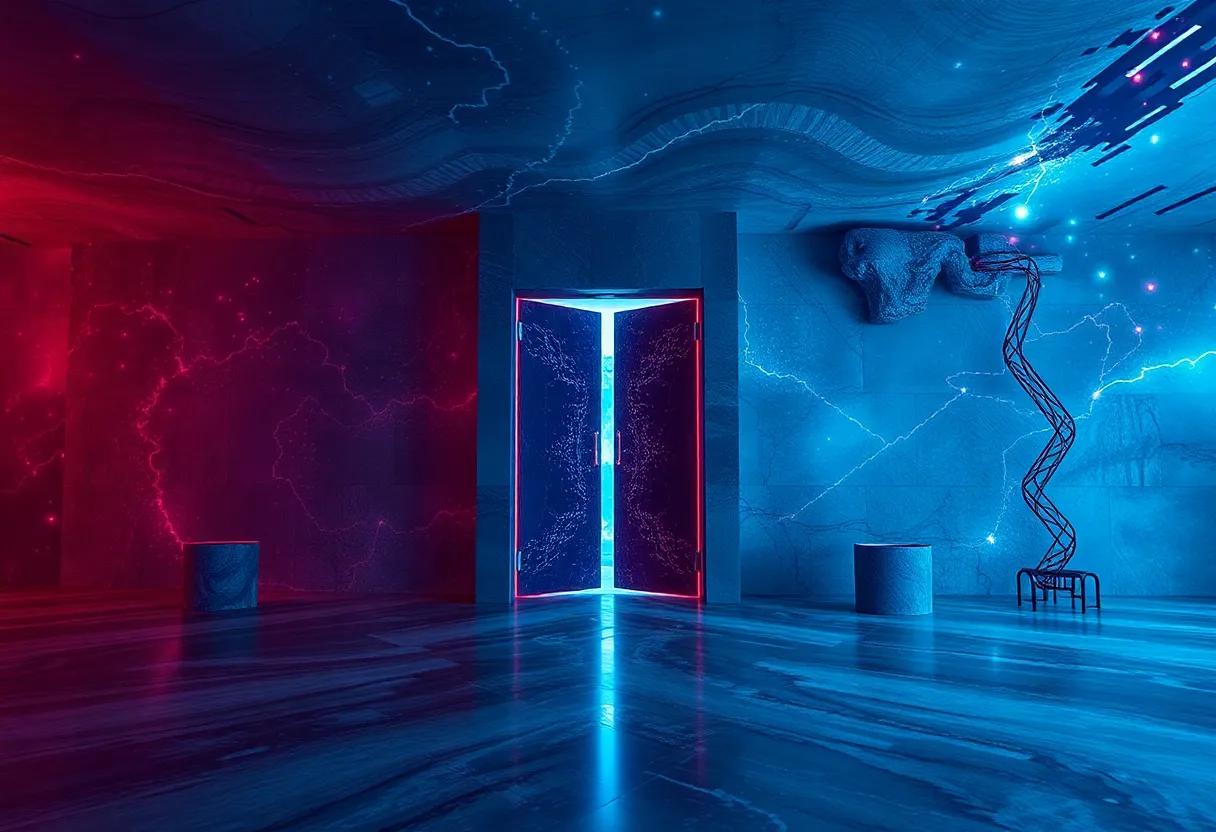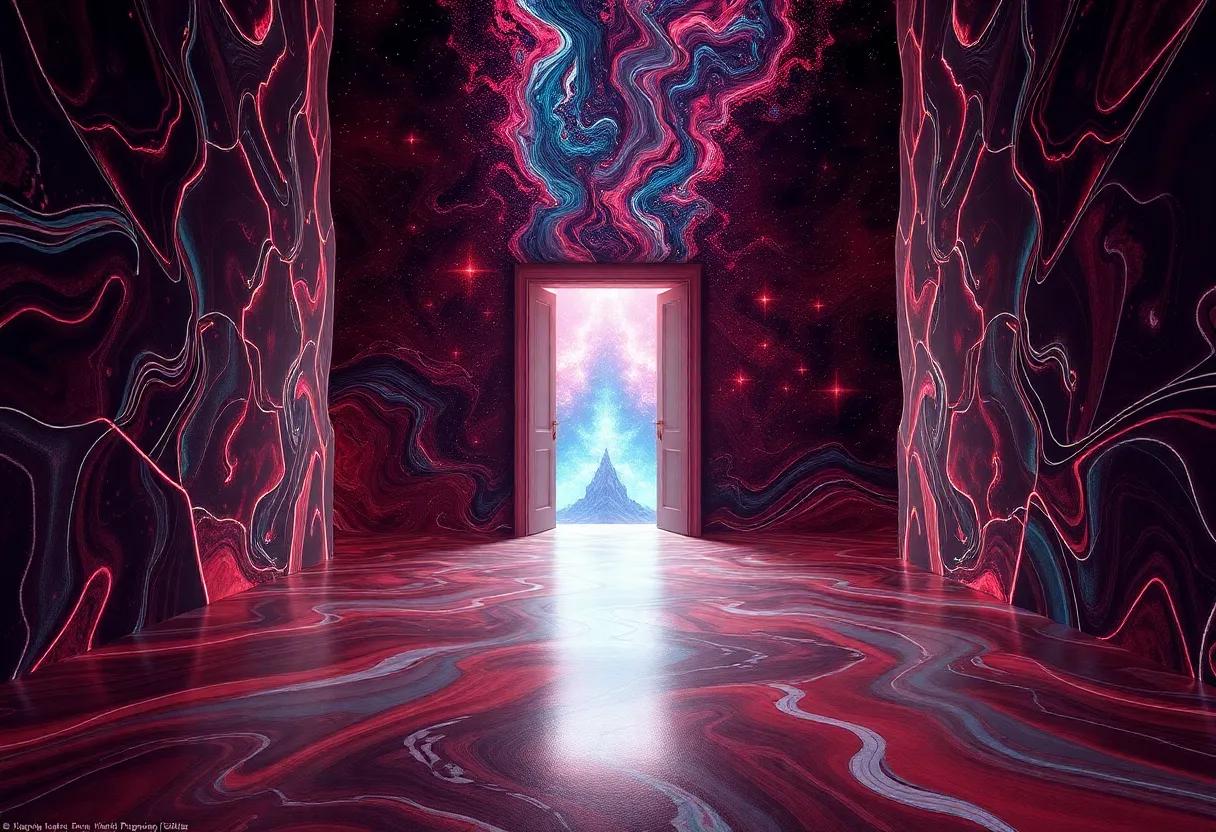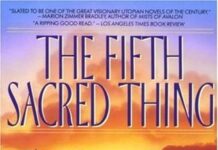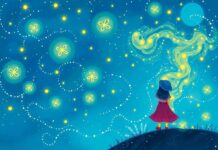In the ever-shifting landscape of human consciousness,few works have dared to navigate the boundaries between perception and reality as boldly as Aldous Huxley’s the Doors of Perception.This seminal text invites readers on a journey through the kaleidoscopic corridors of the mind,challenging conventional understandings of what it means to truly see. In this review, we delve into the depths of Huxley’s exploration, examining how his reflections on vision and substance continue to resonate and provoke thought in an age that constantly redefines the nature of experience.
The Journey Through Altered States and the Nature of Perception Explored in Huxley’s Work
Huxley’s exploration presents a profound inquiry into how altered states of consciousness reshape our sensory and cognitive engagement with the world. By immersing himself in the experiences triggered by substances like mescaline, he reveals a dimension of perception where everyday objects shed their mundane qualities, becoming vibrant repositories of meaning and intensity. This radical shift challenges the conventional boundaries of reality, suggesting that what we perceive as “real” is, in fact, deeply filtered by neural limitations and cultural conditioning. In these liminal moments, the “doors” to a richer tapestry of perception swing open, fostering a unique interplay between subjective experience and objective observation.
- Heightened sensory awareness: Colors become more vivid, textures more tactile, and sounds more resonant.
- Temporal distortion: The flow of time seems to slow or expand, altering one’s sense of past, present, and future.
- Emotional amplification: Feelings intensify, revealing both profound euphoria and subtle anxieties with equal clarity.
| Aspect of Perception | Normal state | Altered State (mescaline) |
|---|---|---|
| visual Experience | Filtered and subdued | Brilliant and intricate |
| Time Sensation | Linear and measured | Fluid and elastic |
| Emotional Depth | Moderate and contextual | Amplified and boundaryless |
Through such vivid portrayals, Huxley urges readers to reconsider the foundations of their perceptual frameworks. The altered states don’t merely serve as escapism or recreational experience; rather, they function as windows into the underlying architecture of consciousness itself. By peeling away the layers of habituated filtering,these experiences question the reliability and completeness of quotidian perception. In doing so, huxley’s narrative invites us to embrace a broader, more fluid understanding of reality where cognition and sensation coexist as dynamic and intertwined forces shaping our awareness of the world.
Dissecting the Philosophical Foundations Behind Doors of Perception’s Views on Reality
At the heart of Huxley’s exploration lies a profound inquiry into the nature of perception itself,challenging the conventional boundaries between subject and object. his account suggests that what we perceive as reality is only a filtered version of a wider, more intricate spectrum of experience, inherently limited by the brain’s neurological mechanisms. This filtering process, referred to metaphorically as the “reducing valve,” acts as a necessary barrier to prevent sensory overload, but it also constricts human consciousness to a narrow band of existence. by temporarily lifting this veil through psychedelic experience, Huxley invites readers to question the rigidity of their sensory limitations and consider a reality far more expansive and interconnected than ordinary awareness allows.
Such reflections stir a dialog between multiple philosophical traditions, especially those concerned with epistemology and metaphysics. The work draws parallels with Eastern philosophies,where the dissolution of ego and boundaries echoes in concepts like maya (illusion) and the unity of all things. Additionally, Huxley’s phenomenological approach echoes Western thinkers who emphasize perception as an active, interpretative process rather than passive reception.Consider the table below illustrating these philosophical correlations:
| Philosophical Tradition | Key Concept | Relation to Huxley’s Ideas |
|---|---|---|
| Eastern Philosophy | Unity of Reality | Breaking ego boundaries via expanded perception |
| Phenomenology | Active Perception | Reality shaped by consciousness engagement |
| Empiricism | Sensory Input Limits | Filters shape understanding of the world |
How the Book Challenges Conventional Understandings of Consciousness and Sensory Experience
Huxley’s narrative plunges readers into a world where the boundaries of perception blur, challenging the typical mechanistic view of consciousness as a passive receiver of sensory data. Instead, he proposes that our minds actively filter reality, functioning like a “reducing valve” that limits the vast stream of information accessible to us. This shift in perspective prompts us to question the completeness of everyday experience and opens the door to realms of vision that might or else remain obscured. The book elegantly dismantles the assumption that sensory experience is fixed, revealing it as a fluid spectrum influenced by biochemical and psychological states.
Throughout the text, Huxley highlights several transformative insights that redefine the relationship between the mind and the external world:
- Perception as an active construction – The conscious mind selectively interprets and shapes sensory input rather than simply recording it.
- Expanded awareness via altered states – Psychedelic experiences can temporarily dissolve habitual filters, exposing a richer sensory landscape.
- Interconnectedness of vision and meaning – Visual perception is intertwined with symbolic and emotional interpretations, challenging purely objective notions of seeing.
| Conventional View | Huxley’s Perspective |
|---|---|
| Consciousness is constant and limited | Consciousness is dynamic and expandable |
| Senses reflect external reality faithfully | Senses filter and distort reality |
| Perception is primarily passive | Perception is an active creative process |
A Close Look at the Literary Style and Narrative Approach That Brings Huxley’s Insights to Life
Huxley’s prose in The Doors of perception is a harmonious blend of poetic vividness and philosophical clarity,making complex ideas accessible without sacrificing depth. his narrative moves fluidly between detailed, almost sensual descriptions and intellectual exploration, inviting readers to both see and think. This duality in style is crucial; it mirrors the very subject of the book - the interplay between sensory experience and mental interpretation. Through lucid imagery and a reflective yet engaging voice, Huxley doesn’t simply report his psychedelic journey; he reconstructs it, encouraging readers to question the fabric of their own perception.
The structure of the essay itself is equally purposeful, resembling a carefully crafted mosaic rather than a straightforward linear narrative. Huxley intersperses personal anecdotes with scientific insights and historical references, creating a multidimensional perspective that oscillates between subjective and objective viewpoints. This technique is reflected subtly in the following outline of his stylistic traits:
| Narrative Element | Function | Effect on Reader |
|---|---|---|
| Descriptive Imagery | Evokes vivid sensory experiences | Engages imagination, creates intimacy |
| Philosophical Reflection | Explores metaphysical questions | Stimulates critical thinking |
| Scientific Contextualization | Grounds experiences in research | Lends credibility and balance |
| Personal Anecdotes | Humanizes abstract ideas | Fosters empathy and trust |
The Role of Psychedelic Substances in Shaping the Themes and Arguments Presented
The influence of psychedelic substances on the narrative cannot be overstated, as they form the very lens through which Huxley examines perception and consciousness. These substances, particularly mescaline, serve as a catalyst that breaks down the boundaries of ordinary reality, allowing Huxley to explore the depths of human experience beyond the veil of everyday sensory input. his vivid descriptions suggest that psychedelics do more than alter perception-they reshape it, unveiling layers of reality that challenge conventional understandings of existence. This expanded awareness becomes a powerful tool for philosophical inquiry, inviting readers to consider alternative frameworks for interpreting both the self and the external world.
Huxley’s arguments are deeply intertwined with the transformative potential of these substances,highlighting themes such as:
- The fluidity of perception: Reality is not fixed but malleable and subjective.
- Interconnectedness of all things: Psychedelics dissolve the ego, revealing the unity underlying apparent diversity.
- Spiritual enlightenment: Enhanced states of consciousness provide pathways to transcendental insights.
| Theme | Impact of Psychedelics |
|---|---|
| Perceptual Boundaries | Expansion and redefinition of sensory limits |
| Ego Dissolution | Temporary loss of self-identity, fostering unity |
| Philosophical Inquiry | New perspectives on reality and existence |
Examining the Cultural and Historical Context That Influenced the Writing and Reception of the Book
When Aldous Huxley penned the Doors of Perception in 1954, the world was perched at the crossroads of tradition and conversion. Post-world War II sentiments, a burgeoning interest in Eastern philosophies, and the nascent counterculture movement all converged to create an environment ripe for challenging perceptions of reality. Huxley’s reflections on his mescaline experience emerged not just as a personal exploration but as a cultural artifact that questioned the rigid frameworks of Western rationalism and materialism. This period saw an increasing curiosity about alternate states of consciousness, fueled by scientific advances and a growing disillusionment with conventional societal norms, which made Huxley’s work resonate deeply across diverse audiences.
The reception of the book was equally shaped by the tension between mainstream skepticism and underground captivation. While many critics dismissed the psychedelic lens as fanciful or escapist, others embraced it as a profound probe into human cognition and spirituality. This dichotomy is reflected in the cultural milieu of the 1950s and 60s:
- Scientific community: Cautious yet intrigued by the potential of psychedelic substances for psychiatric research.
- Literary circles: Viewing Huxley’s prose as both experimental and visionary.
- Counterculture movements: Adopting the book as a philosophical blueprint for expanding consciousness and challenging authority.
| Aspect | 1950s Cultural Climate | Impact on Reception |
|---|---|---|
| Philosophy | Conventional Western empiricism | questioned by Huxley’s mystical insights |
| Science | Emerging psychopharmacology | Cautious experimentation |
| society | Post-war conservatism | Growing countercultural curiosity |
Implications of Huxley’s Ideas for Modern Science,Psychology,and spirituality
Huxley’s exploration of altered states of consciousness challenges the traditional boundaries of scientific inquiry,urging modern science to expand its frameworks beyond strict materialism. His ideas invite researchers to consider the subjective experience as a valid dimension of reality, fostering interdisciplinary approaches that blend neuroscience, psychology, and pharmacology. This shift encourages the study of consciousness not merely as an epiphenomenon but as a dynamic, integral part of human existence, opening pathways for novel therapeutic interventions and cognitive enhancement strategies.
In psychology and spirituality alike, Huxley’s reflections emphasize the importance of transcendent experiences in understanding the human psyche and cultivating self-awareness. His work highlights how mystical states can foster psychological well-being, creativity, and empathy, resonating with practices like meditation or psychedelic-assisted therapy. Key implications include:
- Reconsideration of consciousness as multidimensional rather than reductive
- integration of spiritual insights with empirical research
- Recognition of altered states as tools for mental health and growth
| Domain | Implication | Modern Relevance |
|---|---|---|
| Science | holistic study of consciousness | Psychedelic research,neuroscience advancements |
| Psychology | Understanding of altered mental states | Trauma therapy,mindfulness practices |
| Spirituality | Validation of mystical experiences | Interfaith dialogue,contemplative traditions |
Balancing Skepticism and Open-Mindedness When Engaging with the Book’s Claims
Engaging with Huxley’s vivid exploration requires a delicate equilibrium between doubt and acceptance. While the narrative challenges conventional perceptions, it’s essential to maintain a critical eye to avoid unreservedly embracing every assertion. this balance doesn’t demand rejection but encourages a *thoughtful pause*-an invitation to scrutinize the experiential anecdotes alongside scientific reasoning. Consider how the book pushes boundaries,yet acknowledge that some of its metaphysical claims defy empirical validation. In this dance between skepticism and open-mindedness, the reader cultivates a richer understanding, appreciating the complexity without surrendering to credulity.
To navigate this nuanced terrain,keep these guiding principles in mind:
- Question extraordinary claims by seeking corroborative evidence or alternative explanations.
- Embrace the experiential dimension as a valuable, albeit subjective, component of reality exploration.
- Acknowledge personal biases and how they might color both skepticism and acceptance.
- Allow space for ambiguity-some insights may defy clear categorization.
| Aspect | Role in Engagement |
|---|---|
| Skepticism | Promotes rigorous inquiry, prevents gullibility |
| Open-Mindedness | Invites new perspectives, fosters deeper insight |
Practical Recommendations for Readers Interested in Exploring Perception and Consciousness Further
For those eager to deepen their understanding of perception and consciousness, diving into a variety of interdisciplinary resources is invaluable. Start with experiential practices such as mindfulness meditation or sensory deprivation exercises, which sharpen awareness and highlight the nuances of sensory input. Pair these with reading materials that explore consciousness from different angles-philosophy, neuroscience, and psychology-to develop a well-rounded perspective. Remember, the journey is as much about expanding internal horizons as it is indeed about external knowledge.
- Books: Try works by William James, Daniel Dennett, or Oliver Sacks to complement Huxley’s insights.
- Practices: Mindfulness, lucid dreaming, and sensory experiments can enrich personal experience.
- Communities: Join forums or local groups interested in philosophy of mind or psychonautics.
| resource Type | example | purpose |
|---|---|---|
| Book | The Feeling of Life Itself by Christof Koch | Explore neuroscience of consciousness |
| Practice | Meditative Breathwork | Enhance sensory awareness |
| Digital Forum | Reddit r/psychonaut | Exchange experiential insights |
Comparing Doors of Perception with Other Seminal Works on Mind, Reality, and Vision
Aldous Huxley’s exploration in The Doors of perception stands as a pivotal reflection on human consciousness and sensory experience, often compared to seminal works like Carl Jung’s Man and His Symbols and William Blake’s illuminated poetry. While Jung delves into the collective unconscious and archetypes shaping our inner vision, Huxley ventures through a deeply personal and biochemical alteration of perception, revealing the fine line between reality and its subjective interpretation. Blake’s visionary art and poetry, meanwhile, evoke a metaphysical dimension of reality, where imagination reshapes the visible world-much like Huxley’s mescaline-induced perceptions redefine the boundaries of what is seen and understood.
When juxtaposed, these works highlight different pathways to understanding the mind’s interaction with reality. Consider the following table, which distills the essence of each work’s approach to vision and reality perception:
| Work | Focus | Method | View on Reality |
|---|---|---|---|
| Doors of Perception | Personal consciousness expansion | Psychedelic experience (mescaline) | Reality as a filtered, often limited sensory experience |
| Man and His Symbols | Collective unconscious | Symbolic interpretation of dreams and myths | Reality shaped by archetypes and deep psychological structures |
| Prophetic poetry (Blake) | Spiritual and visionary insight | artistic and poetic imagination | Reality is malleable and infused with divine symbolism |
- Unique Methodologies: Each author uses distinct lenses-chemical, psychological, and artistic-to decode the mysteries of perception.
- Varied Interpretations of Reality: From biochemical alterations to spiritual visions, these perspectives challenge conventional understandings of what is “real.”
- Legacy of Influence: Together, they have shaped ongoing dialogues in philosophy, psychology, and art about the nature of vision and the human experience.
Reflections on How Huxley’s Views Resonate with Contemporary Discussions About Human Experience
Huxley’s exploration of perception challenges the rigid frameworks through which we often interpret reality, inviting a renewed conversation on the fluidity of human experience.Today’s discourse around consciousness, mental health, and even technological interaction echoes his premise that reality is far from fixed – it is instead deeply subjective and colored by individual perspective. Contemporary thinkers emphasize that our understanding of the self, time, and sensory input is not absolute, but rather an intricate dance between biology and environment. This resonates strongly with Huxley’s assertion that expanding one’s perceptual boundaries can reveal hidden dimensions of existence, encouraging a more empathetic and holistic view of what it means to be human.
- Neuroscience and altered states: New research supports the notion that cognitive frameworks are malleable, highlighting parallels with Huxley’s psychedelic experiences.
- Mindfulness and presence: Philosophies stressing awareness and presence align with his idea of “removing the filters” to see reality in its purest form.
- Virtual realities and simulations: Technology’s role in reshaping perception echoes Huxley’s challenge to what is “real.”
| Huxley’s Concept | Modern Parallel | Implication for human Experience |
|---|---|---|
| Mind as a Reducing Valve | Cognitive Bias and Filtering | Limits perceived reality, shaping personal truths |
| Expanded Consciousness | Meditative and Psychedelic States | Facilitates empathy and deeper understanding |
| Beyond Ordinary Vision | Virtual/Augmented Reality | challenges fixed notions of space and time |
The Enduring Legacy and Influence of Doors of Perception in Literature and Popular culture
The ripple effect of Huxley’s exploration of consciousness has woven itself deeply into the tapestry of literature and popular culture, inspiring creators across generations.From the psychedelic-infused narratives of the 1960s to contemporary examinations of perception and reality, his work serves as a touchstone for those delving into the boundaries of human experience. Artists and writers alike have drawn upon Huxley’s insights, often using his metaphor of “doors” to symbolize the potential for expanded awareness and the questioning of normative viewpoints.This legacy manifests not only in direct references but also through themes of transformation, alternate realities, and the fragility of sensory experience.
- Music: Bands like The doors explicitly borrowed from Huxley’s title and philosophy, embedding a lyrical resonance with mind expansion.
- Film and Television: Visual storytelling has embraced the idea of perception shifts, from trippy cinematography to narratives exploring altered states.
- Philosophy and Psychology: Scholars continue to debate and expand on Huxley’s implications about consciousness and identity.
To better appreciate the overarching influence, consider this concise summary of key cultural milestones reflecting Huxley’s impact:
| Era | Notable Example | Manifestation |
|---|---|---|
| 1960s | The Doors (Band) | psychedelic rock & lyrical inspiration |
| 1980s | Stanley Kubrick’s films | Exploration of altered realities |
| 2000s-Present | Contemporary literature | Thematic focus on perception & consciousness |
In essence, the enduring fascination with Huxley’s Doors of Perception can be traced to its evocative challenge to the limitations we impose on our own experience. It is indeed a work that continues to open minds, encouraging society to look beyond the obvious and embrace the extraordinary possibilities of inner vision.
An Insightful Portrait of Aldous Huxley as Philosopher, Writer, and Seeker of deeper Truths
Aldous Huxley emerges not merely as a writer but as a relentless explorer of human consciousness and the cosmic tapestry that binds existence. His works traverse beyond literary boundaries, delving into philosophical inquiries that question the very fabric of reality. Huxley’s prose in The Doors of Perception serves as both a vivid narrative and a contemplative discourse, inviting readers to reconsider the limitations imposed by ordinary perception. He challenges us to embrace altered states as gateways to profound understanding, emphasizing that the mind’s potential is far greater than conventional experience suggests.
Through his distinct voice, Huxley illuminates several core themes that resonate deeply with seekers of truth:
- The permeability of reality: highlighting the fine line between what is perceived and what exists.
- The transformative power of experience: suggesting that expanded consciousness can shift one’s worldview.
- The interconnectedness of all things: an undercurrent urging recognition of unity beyond individual ego.
| Aspect | Huxley’s Perspective | Implications |
|---|---|---|
| Mind Expansion | Tools like mescaline unlock new vistas | Expands consciousness beyond the ordinary |
| Perception | Not absolute but filtered reality | Reality is malleable depending on awareness |
| Spiritual Quest | Seeking beyond the material world | Advocates for inner exploration and enlightenment |
In navigating the intricate corridors of Aldous Huxley’s The Doors of Perception, we find ourselves invited to question the very fabric of reality and the lenses through which we view it. This exploration neither fully endorses nor dismisses Huxley’s visions but rather embraces the complexity of his insights, urging readers to remain curious and contemplative. Whether seen as a profound philosophical inquiry or a curious artifact of its time, the book continues to open doors-if only for a moment-into the profound interplay between perception and existence. As we close this review, the invitation remains: step beyond the threshold of the familiar and explore what lies just beyond the ordinary gaze.

